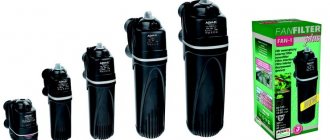As is known, water in a confined space tends to provoke the proliferation of microorganisms contained in it. As a result, its properties deteriorate, an unpleasant odor appears, and further use becomes impossible. Therefore, a UV aquarium sterilizer is practically necessary in this case.
A UV sterilizer for an aquarium is needed to prevent the development of unnecessary microorganisms
Reasons for using ultraviolet light
The flora and fauna of aquariums are not an inert mass that never interacts with the environment. This is a constantly changing system that exchanges substances between all its participants. Among them there may be completely harmless organisms such as bacteria or various viruses, which often become the causes of serious diseases in fish.
And if for the average home aquarist the loss of several small pets is not a major tragedy, large specialized farms that grow certain species may lose the fruits of many years of work due to a sudden epidemic.
Therefore, to preserve the entire brood, ultraviolet sterilizers are used for the aquarium. The radiation they emit is lethal to most harmful organisms that may enter the tank.
An ultraviolet lamp will help prevent diseases in fish
Ultraviolet is the shortest waves of electromagnetic radiation that are outside the visible spectrum for human vision. There are several varieties that differ in the length of the emitted wave and, accordingly, in their penetrating and physical properties:
- A is the longest region and includes the range from 320 to 400 nanometers. Longer - only visible violet light. It is this species that reaches the Earth's surface after being filtered out by the atmosphere.
- B - average in the overall range (290-320 nm), more aggressive. Some of these rays also penetrate through the dense ozone layer of the atmosphere and are well tolerated by living organisms.
- C - the shortest spectrum waves possible in principle, the range is from 180 to 290 nanometers. They have no chance of reaching the surface and are fatal to most living beings.
Any rays can be used as disinfectants, since bacteria and viruses, due to their structure, do not have a natural barrier that would protect them.
How to choose the correct size of UV installation?
This is perhaps the only difficulty in handling an ultraviolet installation. To effectively kill harmful organisms, your UV unit must be suitable for the size of your aquarium. Most manufacturers of UV sterilizers provide their products with a special table. By comparing several well-known models, you will realize that the tables and measurements may differ for each company.
| Manufacturer/Model | Wattage | Max. Liters | Flow strength |
| Aqua Ultraviolet | 15 | 1500 | 700 |
| Angstrom 2537 | 30 | 1500 | 750 |
| Double Helix | 36 | 1500 | 500 |
| Emperor Aquatics | 65 | 1200 | 952 |
| Emperor Aquatics | 80 | 1200 | 1049 |
This table shows the differences between several well-known manufacturers. And as we see, these indicators are quite different from each other. The power that Emperor Aquatics requires is significantly different from other manufacturers. This is explained by the fact that they use an absorption coefficient of water purity of 0.45, and the throughput of the quartz coupling is reduced by 20%. All this reduces UV leakage and improves lamp performance.
Types of aquarium sterilizers
These devices differ according to several criteria. In addition to the emitter power, they can have different design features. For example, the method of interaction with water or the type of attachment to the tank. Basically, according to the type of location, UV sterilizers for aquariums are divided into the following types:
- Built-in ones have low-power lamps, and therefore are least effective in combating outbreaks of epidemics of harmful microorganisms. If the water in the aquarium becomes overgrown and green, it will not help - the rays simply will not penetrate the thickness of completely opaque water.
- Internal - they are mainly part of a filter that is installed inside the aquarium to purify water from harmful salts and waste products of living nature. They disinfect only the volume that is pumped through the flask, and therefore have the same low productivity. However, they are quite suitable for preventing diseases in animals.
Internal sterilizers are equipped with low power lamps - External ones are the most common and effective, they are installed immediately behind the bleeder pump and do their job much faster. Today there is practically no alternative source of ultraviolet radiation for an aquarium.
The design of each of these sterilizers is based on a quartz lamp, which is capable of heating to the required temperatures. It is thanks to this that it is possible to convert the light emitted by it into the desired spectrum and make its rays of the required length. As a rule, each lamp is responsible for its own range, and no adjustments are provided for the built-in crystal.
Advantages and disadvantages
Although a sterilizer is an almost irreplaceable mechanism that allows you to get rid of many problems, it is not without critical disadvantages. One of the main ones is that it gets rid of not only harmful organisms in the water column, but also colonies of beneficial bacteria. Naturally, this applies to mounted or internal sterilizers.
The advantages are almost undeniable. These include:
- Effective counteraction to “weeds” among underwater fauna. For example, blue-green algae, which are capable of quickly multiplying along the bottom and causing heavy silting of the bottom, are very afraid of ultraviolet radiation.
A UV sterilizer will help reduce water turbidity - Reducing water turbidity. The filter mainly copes with this, but at the same time, UV radiation allows you to avoid new outbreaks of the proliferation of harmful bacteria. The products of their vital activity are substances that pollute water.
- Beneficial effect on fish living in the aquarium, accelerating their growth and development. Plants accustomed to high ozone levels in water will also receive a life-giving dose of nutrients and will grow much better.
- Highly effective in outbreaks of pandemics among fish.
- Eliminates the unpleasant odor of stagnant water.
In addition, it is very useful to turn on the sterilizer when new residents are added to the aquarium. They undergo the same procedure as the old inhabitants, and the condition and composition of the water are brought to one common denominator. If a large number of different species of fish live in a small vessel, it is useful to carry out disinfection with ultraviolet light from time to time.
If there are many different types of fish in the aquarium, sterilization is necessary
The disadvantages are less significant. These include:
- Inability to overcome large cloudiness. Here the lamp and filter are powerless, all the water will have to be changed by moving the current residents into a temporary container.
- Not an alternative to backlighting.
- Efficiency is too dependent on power.
- Using it without a filter is impractical in principle, since the flask and lamp will not be able to process water that has not been previously prepared.
In any case, if you choose the right type of device for the volume and intensity of pollution, you can achieve impressive results. The water becomes of higher quality, and the inhabitants of the aquarium live better and longer.
Main characteristics
In order not to waste time making a choice, it is better to first decide on the final parameters of the required device. The most important thing in this choice will be the ratio of the power of the sterilizer, expressed in watts, and the volume of the vessel that will be disinfected. The optimal ratio would be 1 watt per 40-46 liters of aquarium volume. It is worth understanding that the dependence has a damping principle - the higher the capacity, the lower the emitter power required.
The main parameter when choosing UV is its power
The remaining characteristics are as follows:
Based on these data, you can choose a reliable device. You need to be guided, first of all, by the volume of the aquarium, so as not to make a mistake with the power of the quartz lamp.
How to properly operate a UV installation?
The quartz coupling must be cleaned once a month by wiping it with an alcohol solution. Some larger models come with special brushes to make cleaning easier. In most cases, the UV lamp must be replaced after 6 months from installation. However, lamp life may vary between manufacturers, so please check. When replacing or cleaning the lamp, do not look at the device while it is on. This may damage your eyes and cause discomfort. The appliance must be turned off before servicing to avoid electrical shock. A working lamp in air becomes very hot and may burst if placed in cool water.
Principle of operation
To understand the general logic of operation, it is enough to imagine a simple pump that pumps water from tank to tank. Only in this case does such a mechanism discharge water into the same container from which it is taken.
Thus, the approximate procedure for using a sterilizer is as follows:
The presence of a filter in this design is mandatory - it allows you to clean the incoming mixture from the largest particles. These can be either the remains of rotted plants or large fractions of aquarium soil that are in the altered water as a suspension. Thus, the water exposed to radiation gets rid of most noticeable pollutants, and the microbiotic part is removed just by the lamp.
A filter is required in an aquarium with a sterilizer.
Sometimes a filter is also placed on the reverse side, but most designs do without it. Dead and almost completely decomposed bacteria and viruses are not able to resume their reproductive functions in such conditions and do not pose a danger. Subsequently, they simply dissolve in the water without leaving a trace. This is the answer to the question why you need a sterilizer in an aquarium.
There are models that are not immersed in the water column, but are built into the aquarium filtration system. They are more practical, since they do not require any operational effort from the owner, but, being an integral part of the entire structure, they can significantly increase the cost of the tank. If the aquarium filter has a system of fittings, you can buy a special model of a sterilizer that is built into the pipeline after it. It is not recommended to install a disinfectant in front of the filter part; it will not be able to clarify high-quality cloudy water.
Features of operation
The radiation emitted by an ultraviolet lamp is harmful not only to microorganisms. With prolonged exposure, it can even destroy the materials of the flask, which passes water through it for disinfection. Naturally, due to the fact that the sterilizer is not turned on constantly, but only to prevent the formation of colonies of harmful bacteria, such consequences will not happen too quickly. But a device that has been in use for several years requires maintenance or even replacement of parts.
In addition, despite the effectiveness of the filter, which passes clarified and highly purified water, it still leaves a coating on the walls of the flask, formed from salts dissolved in it. This process significantly reduces the effectiveness of radiation treatment, and it is therefore recommended that this tank be cleaned regularly.
The sterilizer should not operate continuously; its radiation is destructive to construction materials
A few simple tips:
These tips will protect you from mistakes when interacting with the device. As a result, it will last longer, and the water in the aquarium will always be of high quality.
Advantages
The main advantage of UV sterilizers is ease of operation and maintenance, as well as the absence of the risk of overdose, and there is no need to conduct any tests.
An important factor is their low energy consumption. As a rule, the power consumption of such a device is slightly more than the rated power of the ultraviolet lamp used in it.
As practice shows, a UV sterilizer is simply not replaceable in case of water bloom caused by an outbreak of euglena or chlorella; in 1-2 days the sterilizer makes the water crystal clear.
At the same time, without going into details, UV radiation stimulates the immune system and the division of plant and animal cells.








